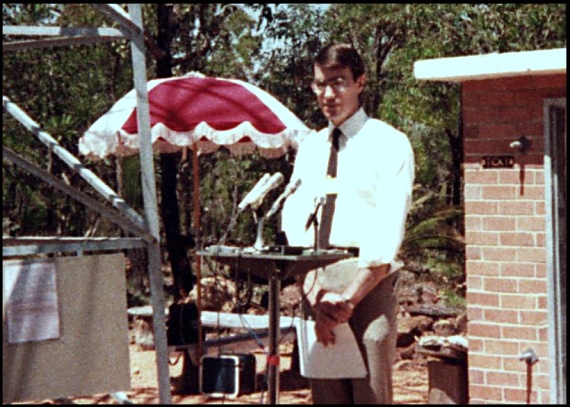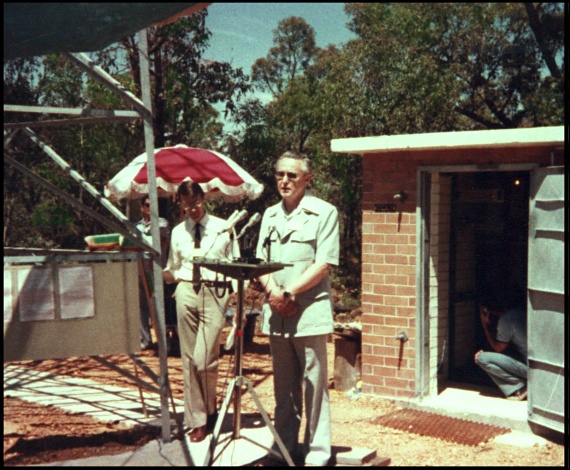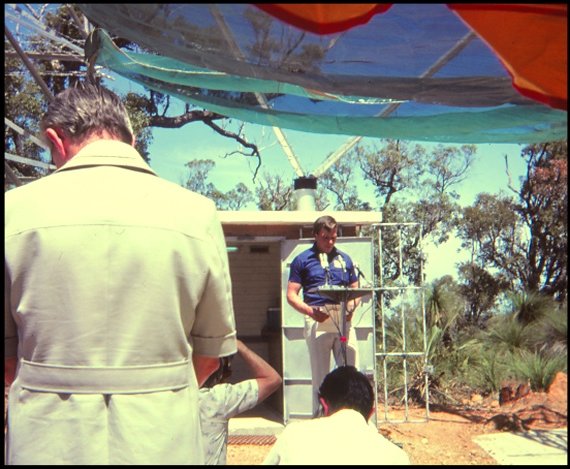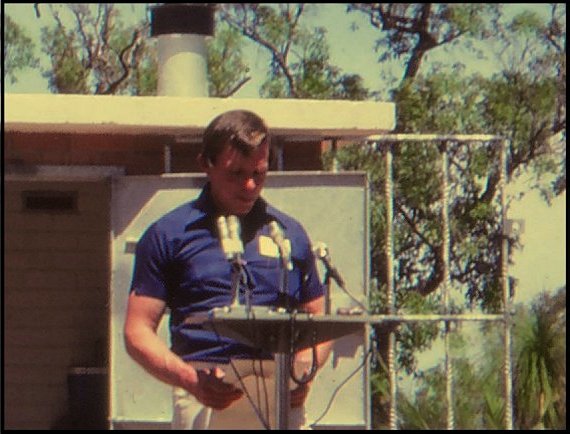|
As told by Jill Weaver VK6YL -- Part two
The events leading up to Concrete pouring day "C" day
were all explained
in the first part of this saga, now it is "C" day minus one.
At 7.15 PM on Friday night we were informed that the
intended cement
truck had a damaged gear box, the readout for the weigh batching
machine
was needed urgently in the country and just to add to our worries the
front
end loader was required by the Quarry to replace another machine due
for
service. Fortunately a substitute cement truck was arranged and
Peter
VK6PO burnt midnight oil constructing another readout for us to use.
Undaunted we proceeded. Over 20 of us arrived on site
at 8.00 AM,
Saturday the 6th of June (1981), compacted the sand and prepared the
formwork
for the shack floor and roof while all the time the rain clouds
darkened
above. Simultaneously at 10.00 AM the Concrete truck, the
Front
end loader, and the rain arrived. For four hours
ingredients
were weighed, mixed, poured, vibrated and shoveled by the very hard
working
team who thanked the truck driver at 2.00 PM and retired very wet, cold
and soggy for lunch in the quarry shed.
 Due to many gallons of water laying on top of the
concrete it was
impossible to trowel it over. It was covered with donated
plastic
and the cleaning up process then began. Meanwhile my OM Bob
(not an Amateur) who had driven the loader all day, continued to ferry
excess blue metal and sand to the hill - filling in potholes on "Tic
Highway"
and leveling out "sump-crushing" rocks until the track became too
slippery
and darkness fell. Around 8.00 PM many very tired but
elated
people wended their weary way home; we had achieved step one of our
goal.
People are wonderful … from several sources we
acquired around 2000
bricks, 1400 new red ones with the balance second hand, which were
transported
to the site in borrowed trailers and cleaned by teams of Amateurs,
wives
and harmonics, who sounded like little elves with their picks and
doonas.
Stan Robson, a bricklayer friend of one of our members volunteered to
build
the shack with our group doing the laboring. Drums and
trestles
were lent by Amateurs, a door frame donated and vent bricks
purchased.
We mixed the cement by hand for Stan who completed the shack in four
working
days and christened it "Ticky". Please note that we call
the
site "Tic Hill". We chose TIC in preference to Tick for
originality.
Much trauma when the day came to lift the roof on top of Ticky …
but with
the aid of a crane - borrowed of course - this was achieved without any
hitches.

Lifting Tic Hill Hut roof

The concrete roof was poured on site on concrete day and
once dry was lifted onto the brick shack. Note the hole for the cables.
Whilst Stan was bricklaying other members were hard
at work removing
the corrugated iron forming which left a beautiful crinkle cut finish
to
the concrete. One of the most back-breaking
jobs
was that of refilling the rocks and gravel around the tower bases and
leveling
off the site. Each week, work continued in an endeavor to
return the area back to a natural contour to allow nature to take her
course
in time to come.
Ilmar VK6ZIB was in charge of the wind generator and
tower which
in no time grew above the trees to 40 feet high. He spent
many
hours of his own time not only on the wind generator and attractively
finished
Zelamite panel housing the controls, fuses etc, but he prepared the
piping
for the co-ax and cables, the bench and many other things - thank you
Ilmar.

Ilmar did most of the wind generator
figuring out and installation

The large wind generator
installed on top of the tower...Will left and Ilmar on right

A moment of contemplation or prayer for
Ilmar...?
Meanwhile other members worked on the 100' antenna
tower.
We
had to pick our days carefully as during winter the rain and winds were
extremely strong - especially for the boys working around the 80' level
of the tower.
One calm Sunday afternoon we ran out of nuts and
bolts.
We were very thrilled when we received a relay from the firm
responsible
for earlier donations to say they would meet us at their business
premises
and give us sufficient to complete the tower.
A tradition was set - hot potatoes at the end of each
working day,
cooked in foil in the coals of the fire originally intended to burn out
a large tree stump. Long after the stump had gone the fire
was lit to provide warmth and a drying agent for the wet and
weary:
Later we enjoyed making a small BBQ from the left over site materials
and
sausages were added to the menu.
We are greatly indebted to the brothers Kevin VK6AKW
and Peter VK6PO
with son Robert for their expertise throughout the project from
beginning
to end, especially with the main tower, liaison with many firms and
hours
of hard work. Peter made a gin pole which allowed us to
lift
the very heavy tower top in place at the 100' level with the 22' 6dB
gain
Co-Linear antenna above this.

Winching up the top section of the main
tower at Tic Hill
Our President Trevor, VK6MS had the unenviable task
of designing
and constructing innumerable items for the site. His
knowledge
and organisation of materials, together with his extensive supply of
tools
never failed to amaze us.
The project would have never eventuated without you
Trevor ......
thank you from all of us.

Above is the original 2
metre 6dB co-linear installed on the top of the main tower for VK6RTH 2
metres. I think this is Martin (no callsign) from Scalar who built and
donated the antenna. This was the antenna that suffered lightning
damage. Note in the picture the batteries and coax (on the large drum)
ready for installation.

The lightning damaged 6dB co-linear which had a lot of water inside. Much barbed wire was run around the entry pipes to
increase security:
later we hope to erect a fence. Lights were fitted inside
Ticky,
which has been painted with several coats of a white water-proofing
solution
on the entire inside and roof top; no mean feat when it was pouring
down
with rain during this process, the solution could only be described as
looking like a soggy flour and water dough … it clung to our
brushes like
glue!

Tic Hill Wind
Generator....There are few photographs.
Will VK6UU, Ilmar VK6ZIB and Barry VK6KBZ continued
working on the
site during the RD contest, taking time off to contact the other
members
participating via the new repeater antennae, wind generator and six
only
2v 500 AH batteries … well done boys! They
discovered that
power line noise was present. Suspecting the 22kV 3-phase
lines
just to the north of the repeater to be the culprit, we set out the
following
Sunday in a 4-wheel drive equipped with foxhunting beam and snoop loops
to track down the offending pole. Murphy showed his
presence
as usual; no power line noise could be heard that day, thought four
very
audibly noisy insulators were located after a spine crunching two hours
almost blazing our own trails in the rocky terrain. The
authorities
have been notified and are going to replace the insulators.
George, the operator of the Catt D988 loader (called
“Betsy”), volunteered
his services with permission of the owners to landscape the terrain
around
our site … we would still be shoveling next Christmas without
his generous
help. Fifty tons of gravel, road base and clay, yuk! Not
too
much clay thank heavens, were carried in the huge bucket and spread
around
the site, with the members shoveling and raking it flat. It
looks lovely, thank you George, for all your work and especially for
our
“pet rock”; all 21 tons of it brought from the quarry to
the site.
Talking of pet rocks, interesting coloured strata was found whilst
jackhammering;
chips of these were sold to boost our very depleted funds.
Spring is now upon us, the wild flowers are in bloom around the area,
and
we hope it will not be long before they return to where we disturbed
the
land.
The repeater has been installed and we are in
readiness for the grand
opening in mid-October. Over 365 day (1 year without
holidays)
working 10 hours each day would have been needed for one man to
complete
the project. There were actually 25 full days (8,760 hours)
worked by the following amateurs, wives, harmonics and friends:-
VK6AD, VK6AUS, VK6AKW, VK6CU, Sue,
VK6EW, VK6FC, VK6HA, VK6HL, VK6KB, VK6KG, VK6KGE, VK6MS,
VK6NWB,
VK6OO, VK6OW, VK6PO, Robert, VK6PQ, VK6RW, Stan Robinson, VK6UO,
VK6UU, VK6YL, Bob, VK6YS, VK6ZBI, VK6ZCK, VK6ZF, VK6ZGA, VK6ZHV,
VK6ZIB,
VK6ZJR, VK6ZKV, VK6ZLT, VK6ZMB, VK6ZBG, VK6ZRE, VK6ZRR, Peter, VK6ZSE,
VK6ZST, Martin, and friend Mark from Scalar.
Many of the Tic Hill construction team
We would like to thank the following, together with
many of our members
list above, for their donations:- Pioneer Quarries, especially George
and
Phil, Cockburn Cement, Swan Portland Cement, Scalar, A and M
Wholesalers,
Ian and Kay More, VK6ABR, VK6EV, VK6IO, VK6NDJ, VK6TO, VK6UN, VK6YE,
VK6ZJS,
with apologies to anyone we have missed. To all those who
purchased
“Pet Rocks”, to members of the WA Repeater Group and all
amateurs and families,
we say thank you for your support.
In conclusion, may I say that it has given me great
pleasure to be
the co-ordinator of this wonderful project … thank you.
This story was published in Amateur Radio Magazine
(August and November
1981).
Opening Day

Bruce VK6OO, then VK6 WIA President,
opening Tic Hill, October 1981.

Barry Field VK6BR DOTC (ACMA)

Trevor VK6MS President of WARG

WARG President Trevor VK6MS talking about
the work required for Tic Hill
There were 4 microphones on the dais and at
least one of them must have been recording the opening. I wonder if the
recording still exists...?
More about Opening Day
Opening day of the Tic
Hill, VK6RTH site, was a big well organised day. It was hot and many
people had to be transported to the site for the opening ceremony. The
guest list included the CEO of the ACMA Barry Field VK6BR and the WIA
VK6
President Bruce VK6OO.
Canvas shade was constructed for the large gathering, along with AC
power to run fridges for the cold drinks.
Even though the repeater, VK6RTH 2 metres had been on test from the
site for a number of days, it had been shut down from early morning of
the official opening and was officially "turned on" by a switch on the
dais. As soon as this happened many amateurs checked in to be one of
the first to be on the list of working the repeater.
From memory I think the speakers at the opening were broadcast on
VK6RTH.
|

